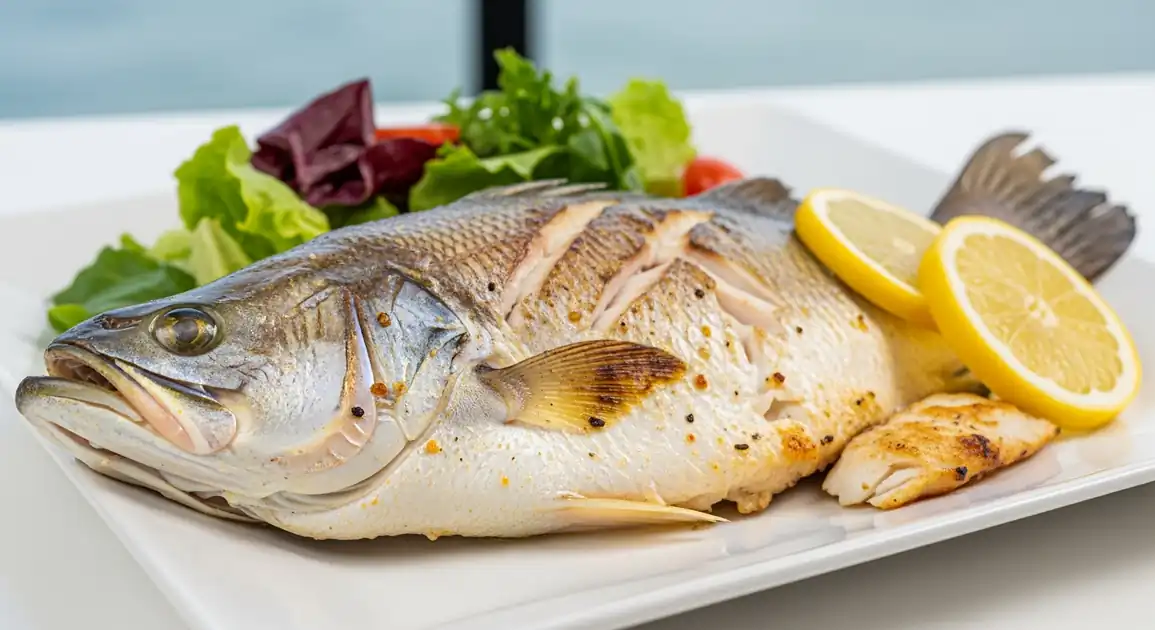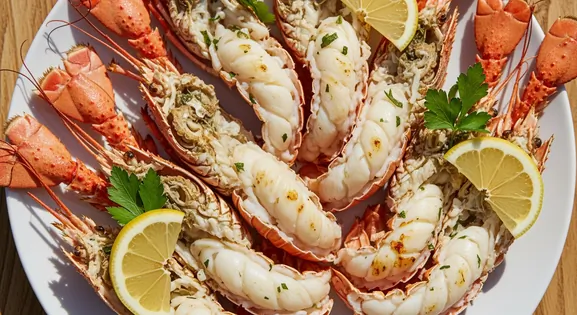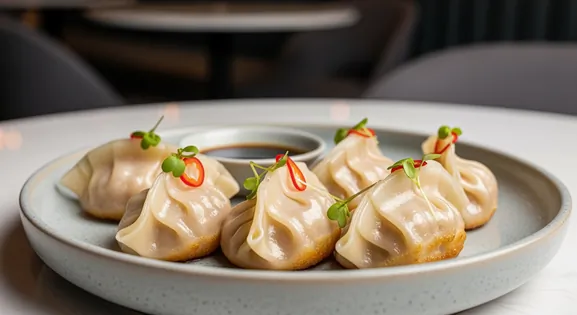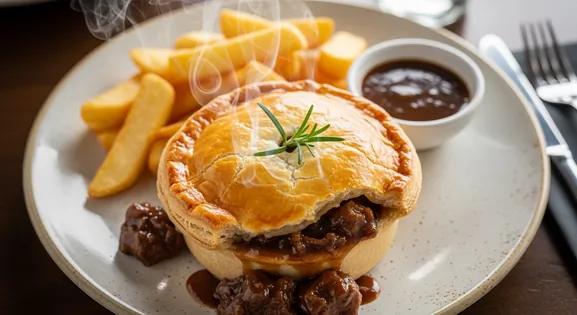Barramundi in Australia: A Complete Food Lover's Guide
Barramundi

Understanding This Dish: An Introduction
Barramundi is an iconic Australian fish celebrated for its delicate, sweet flavour and firm, flaky white flesh. Its name, derived from an Aboriginal term for 'large-scaled river fish', reflects its origins and deep cultural significance. Highly versatile, it's enjoyed grilled, pan-fried, baked, steamed, or famously battered in fish and chips, making it a staple across Australian dining experiences.
From Humble Origins: A Brief History
Native to Northern Australia and the Indo-West Pacific, Barramundi has long been a vital food source for Indigenous Australians, featuring prominently in their traditional diets and cultural practices. It gained mainstream culinary popularity across Australia in the late 20th century, moving from regional specialty to national dish. The development of aquaculture from the 1980s onwards made Barramundi consistently available year-round, cementing its status as a national favourite.
Deconstructing Barramundi: Ingredients and Method
Common methods include grilling or pan-frying fillets (often skin-on for crispiness), baking, steaming (popular with Asian flavours like ginger and soy), or coating in batter/crumbs for deep-frying (fish & chips). Regardless of method, cooking Barramundi until the flesh is opaque and flakes easily is crucial for safety and texture. Its mild flavour pairs well with lemon, herbs, butter, chili, and light sauces.
Key Ingredients of Barramundi
Barramundi Fillet
The star of the dish, Barramundi fillets are celebrated for their mild, sweet flavor and firm, flaky white flesh. This versatile fish can be prepared in numerous ways, from grilling and pan-frying to baking and steaming, making it a staple in Australian cuisine.
Quality indicator: Look for fillets that are moist, translucent, and have a clean, fresh scent, indicating high quality and proper handling.
Lemon
Often served with Barramundi, lemon provides a bright, acidic counterpoint that enhances the fish's natural sweetness and cuts through any richness. Its fresh, zesty notes elevate the overall flavor profile, making it a classic and essential accompaniment to this delicate white fish.
Quality indicator: Choose firm, bright yellow lemons that feel heavy for their size, indicating juiciness.
Fresh Herbs (e.g., Parsley, Dill)
Herbs like parsley, dill, or chives are frequently used to garnish and flavor Barramundi, adding a layer of freshness and aromatic complexity. They provide a vibrant visual appeal and a subtle herbaceous lift that complements the fish's mild taste without overwhelming it.
Quality indicator: Select vibrant, unwilted herbs with strong, characteristic aromas, free from any discoloration.
Local Barramundi Variations in Australia
Grilled Barramundi
Fillet cooked on a grill or flat-top, often served skin-on and crispy. Typically served with lemon, chips, or salad.
Pan-Fried Barramundi
Fillet cooked in a pan, often with butter or oil, resulting in crispy skin and moist flesh.
Battered Barramundi
Fillet coated in batter and deep-fried. A classic component of Australian fish and chips.
Crumbed Barramundi
Fillet coated in breadcrumbs and fried or baked.
Steamed Barramundi
Whole fish or fillet steamed, often with Asian-inspired flavours like ginger, soy sauce, and spring onions.
Classic Pairings for Barramundi
Crisp White Wine
Beverage
A dry, crisp white wine like Sauvignon Blanc or Pinot Grigio perfectly complements Barramundi's delicate flavor without overpowering it. Its refreshing acidity and subtle fruit notes offer a delightful contrast, cleansing the palate and enhancing the overall dining experience.
Fresh Garden Salad
Side Dish
A light, vibrant garden salad, perhaps with a simple vinaigrette, provides a refreshing and healthy accompaniment to Barramundi. Its crisp textures and fresh flavors balance the richness of the fish, offering a complete and satisfying meal.
A Traveler's Guide to Authenticity
What to Look For
-
Fish cooked thoroughly
Flesh should be opaque all the way through and flake easily. This ensures optimal quality and avoids potential issues from undercooked seafood.
-
Fresh smell (clean ocean/water scent)
Applies to raw fish at markets/counters. Avoid any strong 'fishy' or ammonia-like odours.
-
Firm, springy flesh
When buying raw fillets or whole fish, the flesh should bounce back when pressed gently.
-
Clear, bright eyes and red gills (whole fish)
Key indicators of freshness for whole fish. Avoid cloudy/sunken eyes or brown/grey gills.
-
Reputable source (busy market, trusted restaurant)
Vendors with high turnover and good reputations are more likely to handle seafood properly.
What to avoid
-
Undercooked or raw Barramundi
To ensure optimal quality, always confirm it's cooked through until opaque and flakes easily. Only consume raw preparations if from a highly reputable, specialized source.
-
Strong 'fishy' or ammonia smell
A clear sign the fish is old or deteriorating.
-
Soft, mushy, or gaping flesh
These textures are strong indicators that the fish is past its prime and should be avoided to ensure a quality dining experience.
-
Cross-contamination
Ensure raw fish is handled separately from cooked food and ready-to-eat items like salads.
-
Fish displayed poorly (e.g., not on ice)
Fresh fish should be kept properly chilled to maintain quality and safety.
Explore Barramundi in Detail: City Guides
Discover where to find the best Barramundi and learn local tips in these cities:
Dietary Information
Dietary Information
Important Note for Travelers: Your safety is our priority. Below are the common allergens associated with the traditional preparation of this dish. However, recipes and ingredients can vary significantly between establishments. Always confirm all ingredients directly with the food vendor before ordering, especially if you have a severe allergy.
Potential Allergens
Dietary Suitability
How to Order Barramundi
Frequently Asked Questions about Barramundi
What is Barramundi?
Barramundi (Lates calcarifer) is a large predatory fish native to the Indo-West Pacific region, including Northern Australia. Its name comes from an Aboriginal language meaning 'large-scaled river fish'. It's highly prized for its mild, sweet flavour, firm white flesh, and versatility in cooking.
What does Barramundi taste like?
Barramundi has a clean, mild, and slightly sweet taste with buttery notes. Its flavour isn't overly 'fishy'. The texture is firm yet flaky and moist when cooked correctly. This makes it adaptable to various cooking methods and flavour pairings.
Is Barramundi a good choice in Australia?
Yes, Barramundi is a highly recommended choice in Australia, provided it's sourced from reputable vendors and cooked properly. Look for fresh fish (bright eyes, firm flesh, clean smell) and ensure it's cooked through until the flesh is opaque and flakes easily. Only consume raw preparations if from a highly reputable, specialized source.
Is Australian Barramundi farmed or wild?
Both farmed and wild Barramundi are available in Australia. Farmed Barramundi (from QLD, NT, WA) is available year-round and offers consistent supply. Wild-caught Barramundi (mainly Northern Australia) has fishing seasons (typically Feb-Oct) and is often considered to have a superior flavour, though supply can be variable.
Is eating Barramundi sustainable?
Sustainability depends on the source. Australian farmed Barramundi is generally considered a sustainable choice due to well-managed practices. Wild-caught Barramundi sustainability varies by fishery; look for certifications or inquire about sourcing. Australia has regulations to manage wild stocks, but choosing sustainably farmed options is often easier for consumers.
Is Barramundi gluten-free?
Yes, Barramundi fish itself is naturally gluten-free. However, how it's prepared determines if the final dish is gluten-free. Grilled, steamed, baked, or pan-fried Barramundi served without gluten-containing sauces or sides is gluten-free. Battered or crumbed Barramundi (common in fish & chips) contains gluten unless specifically prepared with gluten-free batter/crumbs.
Expert How-To Guides about Barramundi
How to Choose Fresh Barramundi
Select the freshest Barramundi at markets or assess quality when dining out, ensuring you make smart choices for your meal.
- Check the Smell: Fresh fish should smell like the ocean or clean water, not overly 'fishy' or ammoniac.
- Inspect Whole Fish: Look for clear, bright, bulging eyes (not cloudy or sunken) and bright red gills.
- Examine Fillets: Flesh should be firm, translucent, and bounce back when gently pressed. Avoid fillets that look dull, bruised, or separated.
- Assess Skin: Skin should be bright, metallic-looking, and intact.
- Trust Reputable Vendors: Buy from busy fish markets or restaurants known for quality seafood.
- Ask About Source: Inquire if it's farmed or wild, and when it arrived or was caught.
Smart Ways to Enjoy Cooked Barramundi
Ensure your cooked Barramundi offers an optimal dining experience by understanding key indicators of proper preparation and serving.
- Confirm Thorough Cooking: Ensure the fish is cooked through – the flesh should be opaque and flake easily with a fork. Incomplete cooking can impact quality.
- Check Temperature: If possible (e.g., baking), ensure internal temperature reaches ~63°C (145°F).
- Be Mindful of Preparation: If getting battered/crumbed fish, ensure the oil looks clean and is hot to minimize greasiness and ensure proper cooking.
- Choose Lighter Preparations: Grilled, steamed, or baked Barramundi are often healthier and allow the fish's flavour to shine.
- Note Allergens: Be aware of potential allergens in marinades, sauces, or batters (e.g., soy, garlic, wheat). Ask staff if unsure.
- Eat Promptly: Consume cooked fish soon after it's served for best quality and enjoyment.
Our Commitment to Quality
At Tasteplorers, our mission is to provide the most accurate and useful travel information in the world. To achieve this, all content on this site is created through our unique editorial framework. We utilize leading AI research tools, guided by our proprietary prompts, and a multi-stage validation process. This entire system is overseen by our editorial team to ensure everything we publish meets our high standards for accuracy, cultural nuance, and practical value for travelers.
Learn more about our Editorial Process and our Mission.
Explore regions
Europe
Discover Europe's diverse culinary landscape, from Mediterranean flavors to hearty Alpine fare. Learn to navigate markets, decode menus, and eat like a local.
Latin America & Caribbean
Discover the vibrant cuisines of Latin America & the Caribbean. Our expert guide covers everything from Mexican street food to Peruvian ceviche and market tips.
Oceania
Explore Oceania's diverse food scene. Learn about Polynesian earth ovens, Fijian feasts, and the vibrant café culture of Australia and New Zealand.
Southeast Asia
Explore Southeast Asia's diverse food cultures from Thailand to Vietnam. Get expert tips on navigating spice levels, choosing quality vendors, and understanding the rich traditions of the region.






